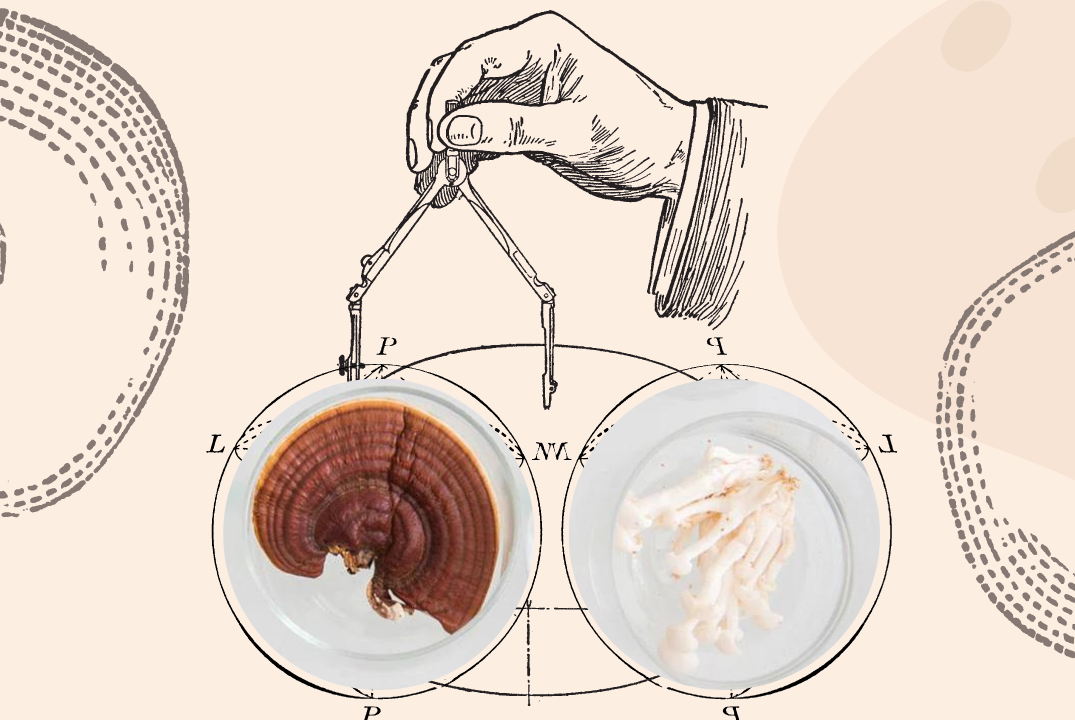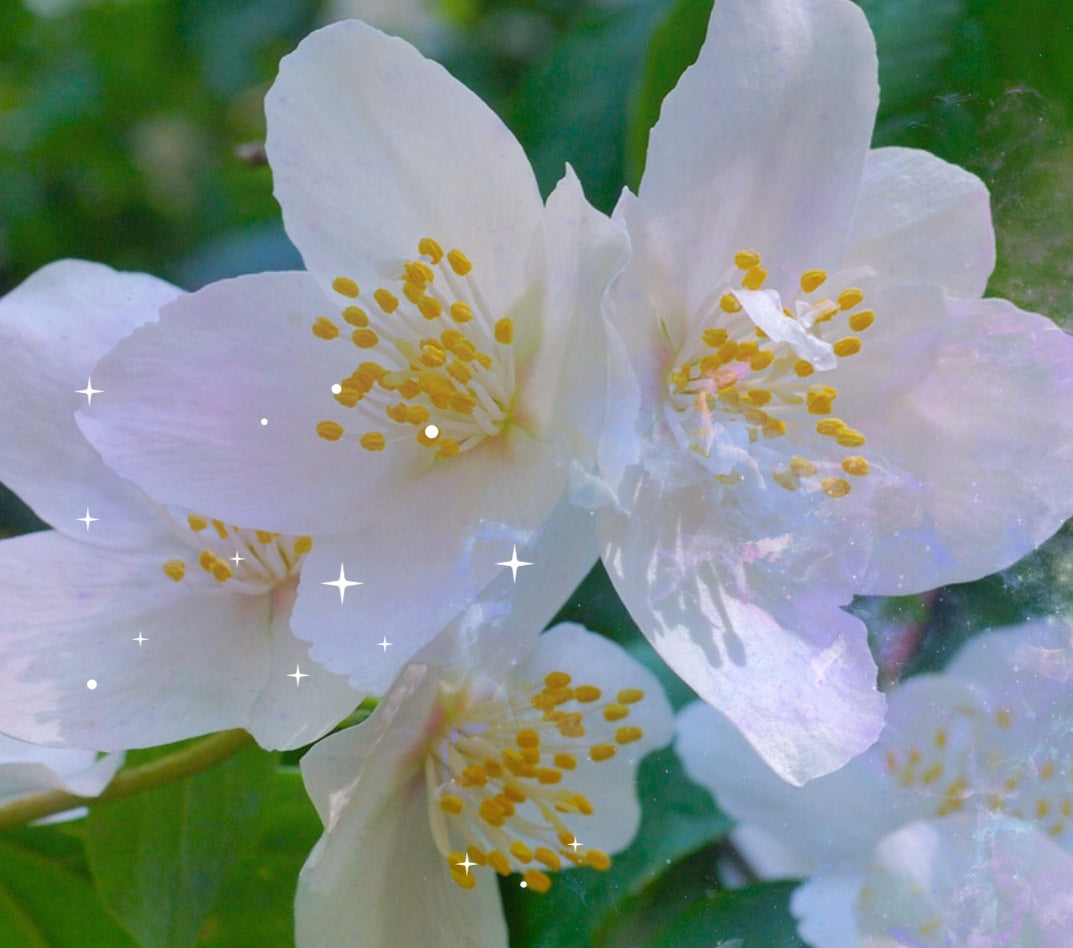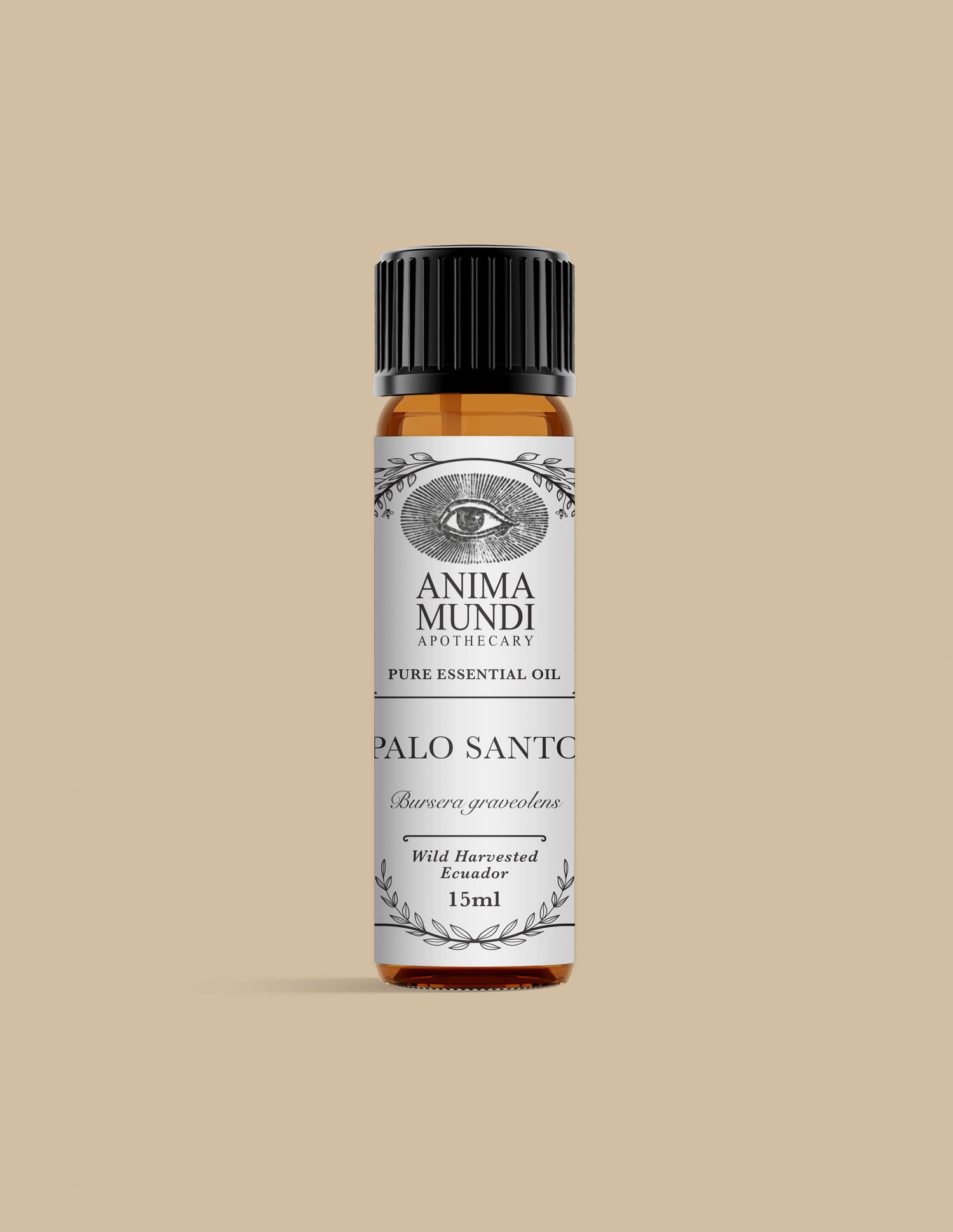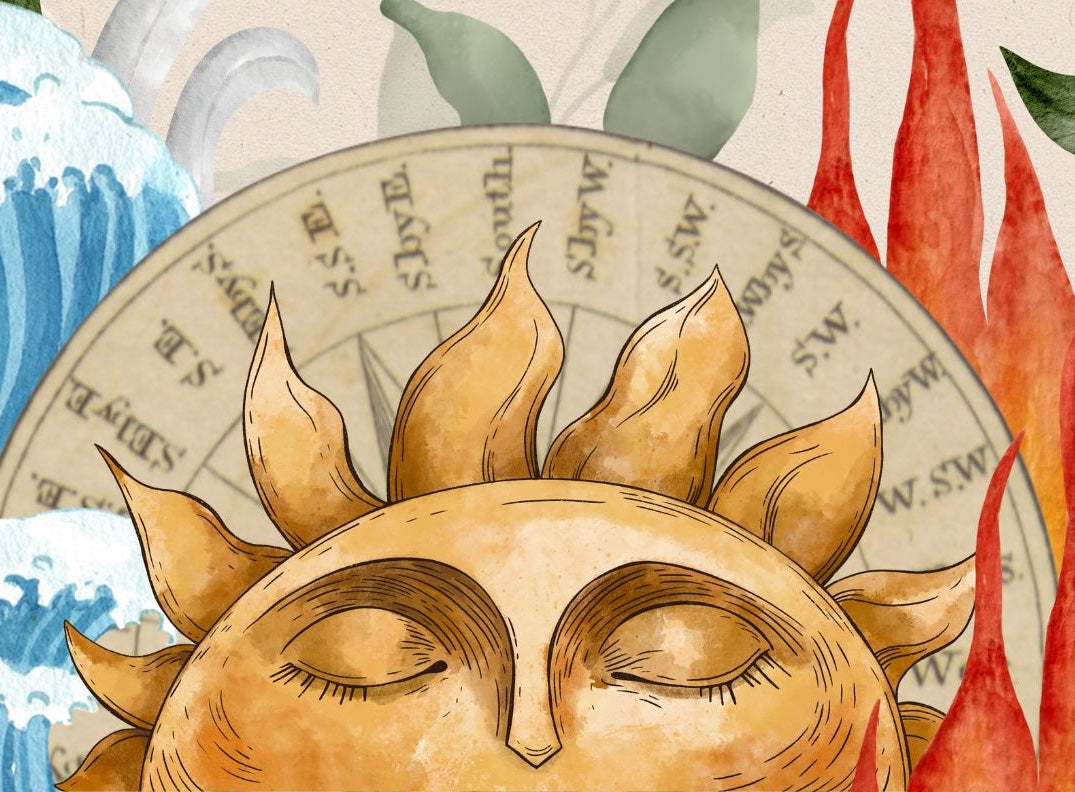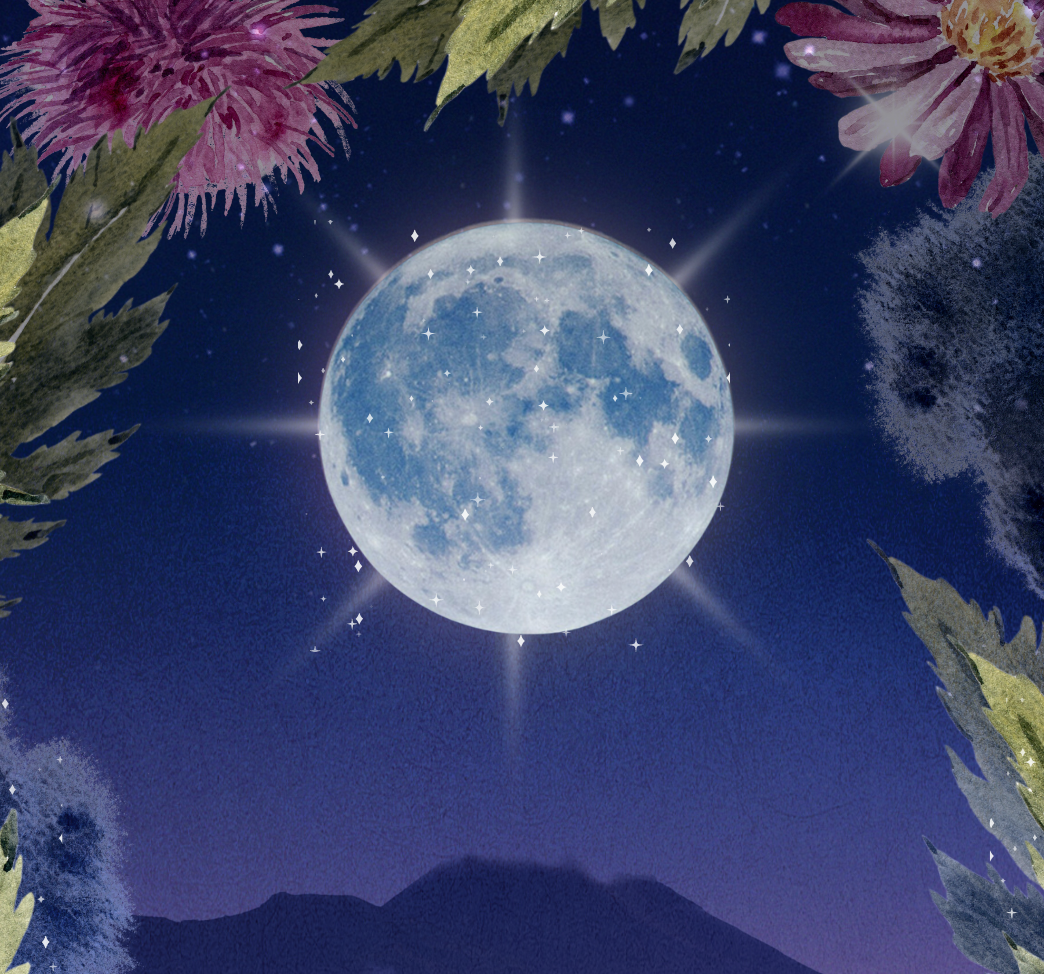This Solstice season, we invite you to contemplate how the light of the Sun and the Moon activates plants, which stimulates them to metabolize and transform the nutrients of the Earth, the moisture of water, and the breath of the atmosphere into medicines.
Historically, traditional herbalists have gathered their medicines from their local regions, and they were acquainted with the best places and times to harvest the plants for maximum potency. The potency of the plants was known organoleptically, through sensory analysis of visual appearance, taste, smell, and physiological reactions after ingesting.
Long distance trade of herbal ingredients was an important part of many cultures for thousands of years, and certain locations were famous for offering the highest quality. We still find this in many herbs and essential oils: the oils from Corsica, such as Helichrysum italicum, are known to have unique chemical and aromatic properties, which are not found in the same species grown in other places.
The medicinal powers of herbs and aromatics are primarily based on what are called secondary metabolic compounds. These chemicals can be contrasted with primary metabolic compounds, which are directly involved in the growth, development, or reproduction of the plant. Secondary metabolites, on the other hand, are mostly required for a plant’s interaction with its environment and produced in response to stress, meaning that they are compounds of immunity, signaling and adaptation. The antibiotic, antifungal, and antiviral properties of secondary metabolites protect the plant from pathogens, which we in turn use to protect ourselves.
If we study the production of secondary metabolites in plants, we find that there are great differences in the quality and quantity produced in the same species from different locations, and fluctuations according to genetics, daily and lunar cycles and other influences.

There are several major eco-physiological factors that directly affect the production of these compounds, including:
◐ Diurnal (daily) rhythm of sunlight and heat, which stimulates photosynthesis;
◐ Lunar cycles, which subtly influence photosynthesis and indirectly influence the water content of plants;
◐ Germination, growth, flowering, and reproductive cycles, which are based partly on seasonal influences and partly on plant genetics, which we could call botanical evolutionary pranic intelligence;
◐ Antimicrobial, pesticidal, and allelopathic (protecting from other plants) functions, which are the plant’s immunological power;
◐ Water and water stress, which have a direct influence on the production of the medicinal secondary metabolites; and
◐ Soil nutrients and conditions.
These environmental influences are present in and around plants from before their germination until completion of their life cycle, and are active in all parts of all plants. The practical importance of this information for herbalists or manufacturers of phytomedicines is to know optimum growing conditions, harvest times, and preparation methods to capture peak levels of therapeutic compounds.
The spiritual importance of this knowledge is enhanced insight into how botanical medicine is an expression and manifestation of celestial, terrestrial, and botanical intelligence and life force. By combining these two understandings, we can cultivate a view of plants that is both clinically practical as well as spiritual and reverential.
Solar Influences
Ecophysiology is the influence of ecosystems on plant physiology. Sunlight drives chemical reactions within plants, and has a direct influence on the production of medicinal secondary metabolites in a number of ways: diurnal rhythms, light-dependent growth phases such as budding, flowering and fruiting times, levels of heat and light intensity, latitude, altitude, and others.
Knowing that solar energy, light, and heat are the powers activating photosynthesis and plant metabolism, whenever we ingest herbal medicines or inhale essential oils we can remember that we are consuming molecular forms of sunlight.
Production of medicinal compounds following diurnal cycles is the most obvious example of the effect of sunlight on secondary metabolites. Diurnal fluctuations of secondary metabolites with medicinal significance have been reported in modern agricultural research including saponins, alkaloids, and essential oils in numerous aromatic plants. Ethnobotanical traditions also contain knowledge and experience of the solar cycle and its relationship to potency of plants, but describe it in different ways.
My teacher of Tibetan medicine, Dr. Ngawang Choephel, told me how he would gather an herb of the same species from different locations: the plant from higher altitudes on the south side of a mountain would have more concentrated fire element, whereas those coming from the shady north side at lower altitude would have more water element. I confirmed this in my own wild harvesting of white sage in the coastal mountains of California, finding that the same plant in the hot dry zones contained significantly more essential oil than those harvested in cool moist zones.
Many plants produce peak concentrations of specific compounds at noon during the highest intensity of sunlight. For example, St. John’s Wort has been found to produce maximum levels of phenolic compounds at this time of day. However, diurnal fluctuations can be expressed at any time of day, such as peak production of carvacrol in certain species of oregano at ten in the morning. Furthermore, even within the same species peaks of different compounds can occur at different times, as in the peak production of thymol at midnight in the same oregano species.  While some species produce maximum levels of medicinal compounds in the full heat and light of the Sun, other species require shade to thrive. For example, the biomass of leaves and roots of turmeric increase significantly when the plant is grown in partial shade as opposed to full sun, and its curcumin content will also be much higher. Cardamom is also a shade-loving plant that has been grown for centuries as an understory crop in old growth forests of India. Species such as these not only offer their medicinal benefits, but are also perfect examples of economically and ecologically sustainable agroforestry. Shade-loving understory plants, however, are particularly sensitive to changes in their environments and therefore more susceptible to damage from the effects of global warming than dominant woody species.
While some species produce maximum levels of medicinal compounds in the full heat and light of the Sun, other species require shade to thrive. For example, the biomass of leaves and roots of turmeric increase significantly when the plant is grown in partial shade as opposed to full sun, and its curcumin content will also be much higher. Cardamom is also a shade-loving plant that has been grown for centuries as an understory crop in old growth forests of India. Species such as these not only offer their medicinal benefits, but are also perfect examples of economically and ecologically sustainable agroforestry. Shade-loving understory plants, however, are particularly sensitive to changes in their environments and therefore more susceptible to damage from the effects of global warming than dominant woody species.
Different stages of growth and development strongly influence production of maximum levels of therapeutic compounds. Budding and flowering phases in particular tend to produce maximum levels of many compounds. Flowering is a response to changes in the length of day and night; this photoperiodic reaction is triggered in many flowering plants by sensing changes in the solar cycle with photoreceptor proteins; the conjunction of sunlight activating these proteins and the internal circadian clock controlled by melatonin allows plants to perceive changes in the length of day and night, which then triggers budding and flowering.
Diurnal, daily peaks of compound production caused by sunlight frequently overlap with either the budding, flowering or fruiting phases of growth. Cases such as these, while being of biochemical interest with numerous practical applications, also reveal the macrocosmic patterns articulated by holistic medicine.
Ramakant Harlalka—an Indian chemist, agronomist, and one of my essential oil mentors—told me:
“It is very important to understand the biorhythms of plants, as the Sun and the Moon are responsible for producing sensory molecules. Jasmine grandiflorum, for example, starts blooming from four a.m. onward, and its maximum fragrance intensity is between thirty minutes before and fifteen minutes after the sun rises. This time is known as ‘Brahma Muhurta,’ or ‘God’s favorite time,’ and it is a very special period in the life cycles of many flowers.”
Lunar Influences
The Moon plays a direct but subtle role in the lives of plants, and is closely related to the water element. Various lunar effects on plants have been observed over time by different cultures, which incorporated the knowledge and experiences into ethnobotanical traditions. These effects are more pronounced closer to the equator, as the Moon orbits closer to the Earth than in higher latitudes.
The most basic and universal observation, now validated by modern research, is that plants draw water inward and upward as the Moon waxes, and that the moisture content then decreases as the Moon wanes.
References from old literature indicate this was once common knowledge. The Roman writer Plinius (23 - 79 AD) advised farmers to harvest their fruit for market at the Full Moon, as it would be heavier, but harvest for their own use at the New Moon, as it would preserve better.
One universal observation common to diverse locations and cultures is that wood from trees harvested at different times of the Moon’s cycle has different qualities. Specifically, it was recommended that trees be felled on the New Moon in the drier phase; this was an important consideration for the manufacturing of products, as it determined how well the wood aged. A number of recent studies have confirmed these practices, including analysis of wood densities and strength, heat values when burned, and other factors.
The Central American indigenous practice of harvesting palm leaves for roof thatching according to lunar phases was recently tested in a joint research project of several US universities, which discovered a significant difference in calcium, carbon, and cellulose content and therefore durability of the leaves.
Bamboo is traditionally harvested at the New Moon rather than the Full Moon, as its water content is lower and therefore less prone to rot and insect attack. A biochemical explanation for this is that the phenols and other compounds of a plant’s immune system become diluted as the water content increases, causing the wood harvested during the more moist phase of the Moon to degrade faster.
Another example of increased water within plants during Waxing Moons is the vanilla orchid. Vanilla growers know that during the Waxing Moon the vines contain more water, which means they should not be trained as they break more easily.

In Sanskrit, the word for lunar energy is Soma; this word also has connotations of nectar, elixir, milk, and the ambrosia of immortality. The two most basic qualities ascribed to the energy of moonlight are cool and moist. This obviously does not refer to the physical Moon, but to the recognized influence of the Moon on the water element, specifically within plants.
The gravitational pull of the Moon affects tidal changes on large bodies of water and can affect levels in wells and springs, but it is improbable that it actually pulls water into individual trees or plants such as bamboo or vanilla. What is more probable is that moonlight has some type of vitalizing effect on the growth of plants in the waxing phase, which in turn stimulates water absorption and metabolism.
One study measured the growth of various flowering plants in the spring. It was found that their growth rates are influenced primarily by heat and cold, with warmth stimulating growth and cold slowing it; however, it was also found that some species grow more independently of temperatures during the Full Moon, indicating a vitalizing effect. About a dozen species of brown algae such as Fucus and Sargassum have Moon-related reproductive cycles. Both freshwater and marine species of green algae have similar periodicities in reproduction as well.
Moon-related rhythms in higher plants have been regarded as empirical truth by traditional agrarian cultures, and form the basis of different systems of planting and harvesting cycles. Modern research has confirmed some aspects of this, however, reports are inconsistent, with some species growing faster during the Full Moon, others during the New Moon, and others in moon-related cycles at other times; the commonality of these observations is cyclical oscillations of growth. One possible explanation for the variability is that the Moon’s influence does not wax and wane only with the Full and New Moons, but also with other rhythms of the Earth-Moon relationship.
In some species, the presence of moonlight causes earlier onset and increased proliferation of flowers, while in others it inhibits flowering; some species have developed mechanisms of folding their leaves to shield themselves from moonlight, which disturbs their internal photoperiodic cycles. Since the production of medicinal compounds is strongly correlated with budding and flowering phases, it is reasonable to expect that increased or decreased flowering in response to moonlight would be accompanied by increases or decreases in levels of those compounds.
My mentor, Mr. Harlalka, had this to say about the Moon:
“The dawn of Full Moon days in particular is a very unique time for the development of sensory molecules in the plant kingdom, as well as a very energetic time for animals. According to Indian philosophy, the Moon is responsible for creating sweetness. For this reason, people put sweets and herbal medicines under the Full Moon to receive a shower of nectar, and then eat them in the morning. Likewise, the formation of sweet-smelling molecules like epi-methyl jasmonate in Jasmine grandiflorum is the highest when the Moon is in its full power. Roses also produce their maximum fragrance in the morning, especially on the Full Moon day of April. These types of flowers are harvested before the redness goes out of the sky at dawn, and taken directly to the processing unit to avoid losing those sweet molecules.”
To continue your studies of how the Sun and the Moon create medicine, please enjoy this free New Moon Meditation, or use the code ANIMAMUNDI for 25% off your first natural medicine consultation.





